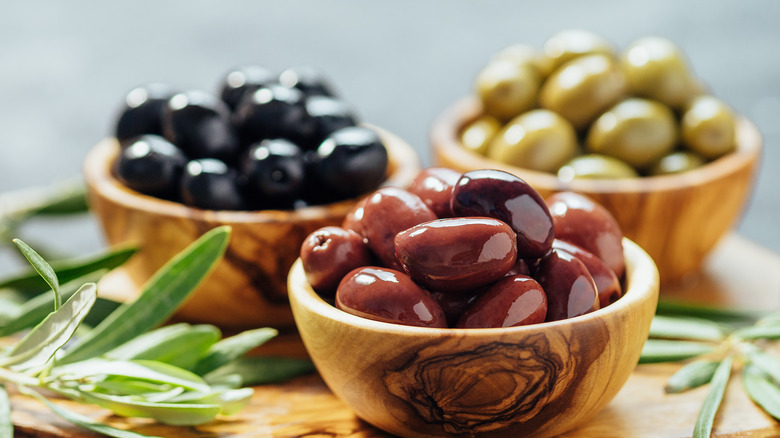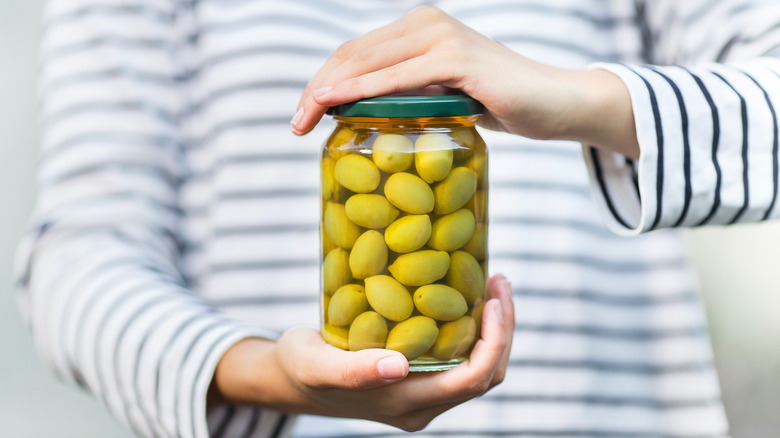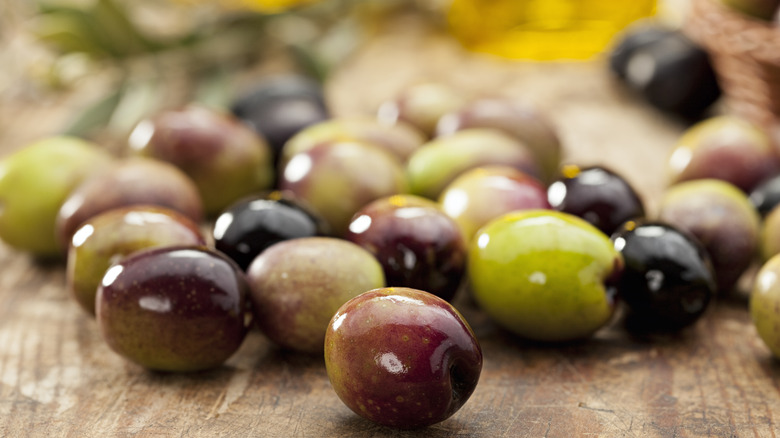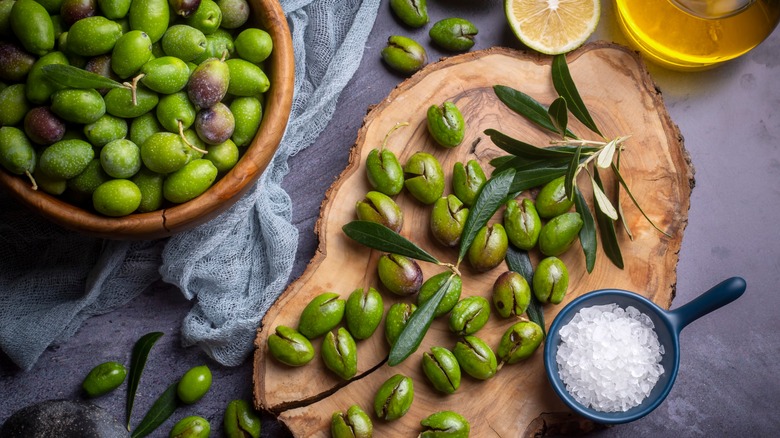How To Tell If Olives Have Gone Bad
Olives are the it-food of the culinary world. An essential part of every grazing board and aperitif offering, they're a great snacking companion, but they're also so much more. Olives can add complexity to all sorts of dishes from pasta sauces to salads to braised meats. Along with imparting a briny punch, they can leave traces of flavor that range from nutty to herbaceous, sweet to salty, and even mild to pungent, depending on the cultivar and processing. Although working olives into any recipe is easy enough, sometimes jars can sit idle in your fridge or pantry, which is why it's fair to wonder whether or not they've gone bad.
Despite their long shelf life, olives do (eventually) go bad. The reasons vary from how they are produced and packaged to how they are stored. Whole olives in contrast to pitted or stuffed options can affect timelines much like whether they're packed in salt, brine, oil, or vacuum-sealed. In fact, different brands may have diverse shelf lives, as well. However, under the right conditions, it generally takes a while before olives should be tossed — the question is, how exactly can you tell if olives have exceeded their prime?
How long are olives usually good for?
Green, black, or purple, Food Safety reports that olives should be consumed within 18 months if they're canned or packaged, and roughly within 2 weeks once opened or if purchased fresh. However, these time frames may vary depending on storage and handling.
Generally, liquid-packed olives will always last longer than dry-packed olives (think: salad bar olives, but also salt-cured) as submerging them in brine or oil can help preserve textures and flavors, along with keeping bacteria at bay. That said, olives stored in brine tend to last longer than those submerged in oil, given that fats can go rancid when stored improperly.
As for those best-before dates listed on jars, take them with a grain of salt. They're there to assure quality since it can take a toll over time. Consequently, even if olives that have been commercially processed can last several years, it's wise not to keep unopened jars for more than a couple of years. Instead, aim to eat them within a few months of the date — and eat them quickly once opened. In contrast, expiration dates listed for opened containers should be taken more seriously seeing as spoilage occurs more rapidly when olives are exposed to external elements.
How to determine if olives have actually gone bad
One of the key ways to tell if your olives have gone bad is by evaluating their scent. If the packing liquid (oil or brine) smells putrid or the olives themselves have a funky aroma, it's wise to discard them. But, appearance also matters. While they won't change color if they've spoiled, you should keep an eye out for mold. Fuzzy olives should be tossed immediately. On the other hand, should the liquid develop a layer of white film, don't fret. Simply scoop it off, add a splash of vinegar, and eat them as you normally would.
If olives have passed the "sniff and see" test, go ahead and give them a sample. If at this point you notice flavors that are slightly off, it's best to toss them and pick up some new varieties during your next market run.
Lastly, just because you have yet to open a jar, can, or package of olives, that doesn't mean it's safe to assume that they will still be in good condition. Aside from considering general shelf life, it's important to carefully examine packaging. Dented cans, bulging jar lids, or torn vacuum packaging can all indicate that quality has been compromised, and olives need to be discarded.
How to store olives
To prevent premature spoilage, correct storage is a must. In the case of unopened olives that are packed in brine, oil, salt, or vacuum-sealed, they can all be kept at room temperature. Just make sure to not store them in the path of direct sunlight or heat sources as this can negatively impact quality. Stowed inside a kitchen cabinet or on a pantry shelf, unopened olives will be just fine.
Like most ingredients, once they've been opened, olives are best stored in a cool area like the fridge — but you could freeze them (after removing brine) to extend their shelf life. Keep in mind, however, that fridge storage is the better storage method of the two. While it's enough to keep dry-packed olives in sealed Tupperware, liquid-packed versions should also always be submerged in their brine or oil to maintain textures and flavors. Did you dump your brine or used it all in a dirty martini? Replenish the liquid by mixing together a saltwater solution to pour over the olives.
A final piece of advice is to do your best to minimize cross-contamination. In order to reduce the risk of olives going bad before they should, don't stick dirty utensils or germy fingers into opened jars as this can encourage bacteria to grow. Likewise, seal containers tightly after each use. Following these tips, you'll be able to enjoy olives well before they even near spoilage.



